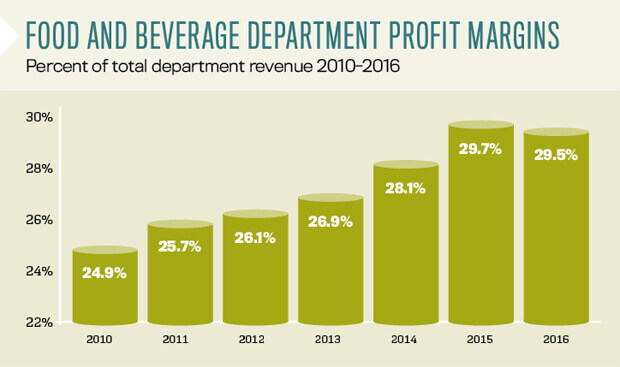
Consumer dining trends tend to be more volatile than lodging trends. Recognizing this, hotel managers have made some significant changes in the way they offer food and beverage service to their guests. The traditional three-meal, all-purpose restaurants and room service are disappearing. Taking their place are self-service kiosks and grab-and-go concepts that provide quick service for in-house guests. These changes help explain recent changes in hotel food and beverage department revenues, expenses, and profits.
To understand recent trends in lodging food and beverage sales, we analyzed the financial performance of hotel restaurants, lounges, room service, and catering departments for the period 2010 through 2016. The information came from a same-store sample of 705 full-service, convention, all-suite, select-service, and resort hotel operating statements taken from the firm’s Trends in the Hotel Industry database. In 2016, the hotels in the sample averaged 365 rooms in size, 76.5 percent in occupancy, and an average daily rate of $201.99.

Out of the Room
From 2010 to 2016, total food and beverage department revenue increased at a compound annual growth rate (CAGR) of 4.5 percent. This is less than the 5.6 percent CAGR in rooms revenue, and 5.2 percent CAGR for total hotel operating revenue during the same period. With total revenues increasing at a greater pace, food and beverage revenue measured as a percent of total revenue declined from 30.4 percent in 2010 to 29.2 percent in 2016. Being a same-store-sample, this reflects changes in existing operations. Given the recent proliferation of new limited and select-service properties, the decline in food and beverage revenue as a percent of total industry-wide revenue would be more dramatic.
In 2016, six of the eight food and beverage revenue categories tracked by CBRE showed more than the nominal dollars achieved in 2010. The two sources of revenues that continue to lag are in-room dining and mini-bar. It is interesting to note that both of these revenue sources are earned while guests remain in their rooms. The decline in revenues from in-room sources is consistent with the emphasis hotel brands have placed on new food, beverage, workspace, and socializing concepts in the lobby area.




